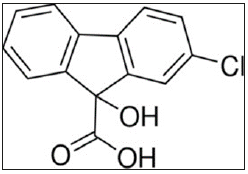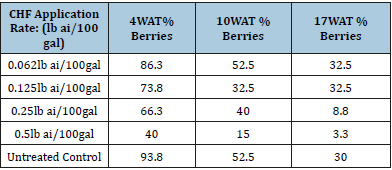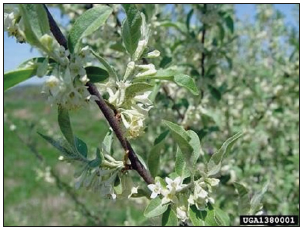- Submissions

Full Text
COJ Technical & Scientific Research
Autumn Olive Control with Chlorflurenol
Bhushan Mandava*
USA
*Corresponding author: Bhushan Mandava, USA
Submission: August 06, 2019; Published: August 22, 2019

Volume2 Issue3August, 2019
Abstract
Autumn Olive is classified as an invasive species in North America. In order to prevent propagation through fruiting, chlorflurenol is proposed to control Autumn Olive berry set. Maintain CF 125 is a formulation of chlorflurenol that is recommended for use as a foliar spray at the time of bud break. The fruit is eliminated with an application of 0.5lb of chlorflurenol diluted with 100 gallons of water. This approach allows the users to enjoy the benefits of the shrub while controlling its invasive characteristics.
Keywords: Autumn olive; Chlorflurenol; Invasive species; Maintain CF 125; Plant growth regulators; Berry control; Fruit set
Introduction
Non- native plants are found everywhere in the United States. It has been known that permitting these species to multiply carries the risk of reducing biodiversity due to their competition with native plants over resources and sunlight. A common approach among ecologists and biologists is to push for the elimination of these non-native species. Some of these species, however, can have potential advantageous effects in their new environments which could be a supporting factor in campaigning for the cultivation of these plants. These benefits can include providing wildlife with an abundant food source, natural fencing for farmsteads and even ornamentation for landowners. For example, the population of fruit eating birds in the Happy Valley region are dependent on the quantity of honey suckle (an invasive species) in that area. Care should be taken when proposing the complete elimination of a non-native species that could be vital for an improved ecosystem [1]. The autumn olive is an upright, deciduous shrub that can reach heights of up to 20 feet tall. The plant is indigenous to eastern Asia. It was brought to North America to restore degraded and deforested lands as well as for wildlife food and cover. It is now classified as a highly invasive species in the United States.
Autumn Olive is among the first few plants to leaf out in the spring and can grow vigorously in full sunlight, which allow it to aggressively suppress native plants and significantly affect pasture productivity. It can seed in entire areas creating monocultures that replace native species. In addition, it can fix nitrogen in the soil. This gives Autumn Olive the ability to provide its own fertilization and live even in the most infertile soil [2]. An individual plant can produce up to eight pounds of fruit each season and the birds that eat these fruits are the primary vector for the dispersal of its seeds. On the other hand, there are many properties of Autumn olives that wildlife management and landowners find very attractive. The strong dense shrub is good for nesting and protective cover for birds and wildlife and is often planted by wildlife management. In addition, they are used as screens and barriers along highways, windbreaks and shelterbelts for farmlands as well as for erosion control for road banks and other steep disturbed sites. In addition, autumn olives are very effective in reclaiming mine spoil because of their ability to fix atmospheric nitrogen in its roots which allows for the enhanced growth and increased yields in adjacent plants. This allows Autumn olive to be used as a soil forming plant for desired species where they can slowly be removed as a higher quality ecosystem is established. This benefit is crucial in providing a healthy habitat for future plant growth in an otherwise vegetation desolate area [3-5]. Interestingly enough, Autumn olive does not behave as an invasive plant on the west coast of the United States and is commonly planted for permaculture systems there. Regardless, due to its aggressive proliferation in other areas of the United States, the current recommendation is to eradicate the plant entirely to prevent invasion of that area. Here we will discuss the current control methods and present a proposed control method which may allow for the enjoyment of the autumn olive’s favorable properties while constraining its invasive characteristics.
Current Control Methods
Autumn olives are a very difficult plant to eliminate once established and can be nearly impossible to eradicate. The most important goal in controlling autumn olive is the prevention of seed production and dispersal. There are a few methods for the control of Autumn Olives that can be classified under mechanical, herbicidal, and biological controls.
Mechanical control
Mechanical control of these shrubs can be accomplished through cutting, girdling, burning or uprooting if there is a small infestation. However, this becomes impractical when the plants become medium to large and infestations become dense. Autumn olive can resprout vigorously after these approaches are used, and often grow even more robustly. In addition, these methods can be extremely labor intensive and require a lot of resources that are not available to many landowners which can discourage people from using them.
Biological control
Biological control methods of Autumn olives have not been studied extensively. Current methods involve the use of sheep and goats to graze on the plants [6]. This method has not been shown to be very effective due to the limited control and animals will commonly eat non target species indiscriminately as well.
Chemical control
Currently herbicidal control is the most effective way of dealing with infestations. Like with mechanical controls, optimal herbicide effectiveness is achieved when well-timed applications take advantage of the seasonal changes in the plant’s physiology. Repeated applications during successive growing seasons are often required. Herbicides that are commonly used include glyphosate, triclopyr and picloram. Cutting the plant off at the main stem at ground level and applying the herbicide to the cut stump has been effective in killing root systems and preventing re-sprouting. With cut-stump treatment, the herbicide is applied specifically to the target plant, reducing the possibilities of damaging nearby, desirable vegetation. Many of these herbicides, however, are nonselective herbicides, so surrounding non-target species are at risk of injury as a result of residues that remain in the soil. Bees and wildlife are also affected by the use of herbicides which can affect pollination and proliferation of other flowers and native species. Herbicides in addition require permits and permission from other landowners in the area [7,8].
Other methods/ intro to proposed method
Elimination or thinning of fruit and pollen can inhibit propagation of plant species. This can be done through both mechanical and chemical methods which allow for the survival of the plant but provides a control method over the population. Fruit thinning has been practiced throughout history and serves a number of purposes. Too many fruits per tree can result in small fruit size and poor quality, breakage of limbs, exhaustion of tree reserves, and reduced cold hardiness. Because of the difficulty in completely eradicating the Autumn olive, this approach should be an emphasis for study in the future. Instead of the labor and resource intensive approach of the methods listed above, single applications of certain plant growth regulators could prevent the Autumn olive from fruiting which would greatly inhibit the proliferation of the shrub while still maintaining its beneficial properties.
Proposed Approach/Results
Chlorflurenol is a member of a group of substances known as morphactins that have the ability to modulate the expression of plants. Morphactins are generally effective in inhibiting seed germination, bud sprouting and growth of seedlings. Chlorflurenol itself operates as an auxin inhibitor. It shows strong acropetal movement (movement towards the shoots and fruits) and weak basipetal movement (movement towards the base of roots) which has the benefit of eliminating fruit set while allowing the rest of the shrub to develop normally (Table 1). It has also been shown to reduce the size, viability and germination of pollen which indicates high utility in controlling the propagation of plant species. Chlorflurenol has shown no phytotoxicity so it’s use is much safer to surrounding wildlife and crops compared to treatments using pesticides such as glyphosate and picloram (Figure 1).
Figure 1:Chemical structure for chlorflurenol.

Table 1:At lower concentration (0.062 -0.125lb ai/gal) does not show any (fruit elimination) activity.

Rates of 0.125-0.5lb ai/gal showed less foliage than untreated plants.
A field trial was conducted to determine the effectiveness of chlorflurenol to suppress autumn olive’s berry formation. Chlorflurenol was applied to autumn olives at bud break in late March at application rates of 0.062, 0.125, 0.25, and 0. 5lba.i/A. This study was conducted on autumn olive trees at Virginia Poly Technical Institute in Montgomery, VA. A solution of chlorflurenol was sprayed onto the foliage of the trees at concentrations of 0.062 to 0.5la ai/100gal. Applications were applied at bud break and full foliage stages and percent berry suppression was assessed three times throughout the experiment. It should be noted that chlorflurenol has the ability to increase flowering development at very low concentrations which accounts for the fact that at rates of 0.062 and 0.125lbai/100gal, there was an equivalent or marginally higher fruit set than the control. The results show that CHF is an effective treatment for berry control in autumn olive, but that proper application time is important. At rates of 0.125 to 0.5 lbai/100gal berry set was suppressed by 30% and 60% respectively compared to the control 4 weeks after the application (Table 2). By 17 weeks after the initial application, berry set was suppressed by 70 and 90% respectively. From the data, it can be observed that increasing rates of chlorflurenol has a direct relationship with the percentage of berry control on Autumn Olives. In addition, no phytotoxicity was observed throughout the study indicating that CHF will not cause crop injury to autumn olive itself or surrounding plants and crops.
Table 2:

Discussion
The adventive nature of Autumn Olive and its potential to proliferate rapidly may cause problems for landowners, disrupt natural growth in many areas, compete with desirable native species, and may require large expenses for maintenance and control. It has been suggested that the Autumn olive would be an ideal plant if technology could cultivate an autumn olive that would have all the benefits but would not fruit and become invasive. Removing a functioning part of an ecosystem, whether invasive or not can cause an imbalance. The problem arises however when invasive plants are allowed to grow unchecked. Eliminating fruit set in Autumn olive would prevent birds from dispersing the seeds which would take away the shrub’s main method of propagation. It is possible that this can be achieved through the use of chlorflurenol. The use of chlorflurenol to eliminate fruit set may be more advantageous then other control methods. Most control protocols try to eradicate the shrub entirely through digging up plants with machinery, burning, or using herbicides. All of these methods are labor intensive and have the potential to harm surrounding crops and wildlife. Chlorflurenol is non-phytotoxic and does not have the potential to harm the target plant nor the nearby organisms (Figure 2). It has been shown within four to eight days after application of chlorflurenol, residues of the compound were nonexistent in the soil.
Figure 2:The flowers of this plant contribute to its attractiveness as an ornamental shrub.
Photo: Melody Rose, Davesgarden.com.

Percent Berry Suppression Table was constructed using the following equation:

No degradation of soil or side effects of the microflora and physiological processes of the soil were observed. Chlorflurenol is an exceedingly safe and effective alternative to the drastic measures that many land and farm owners are forced to use to resist invasion of Autumn olive. At a concentration of 12.5% (Maintain CF 125), applications of Chlorflurenol at bud break have been shown to inhibit fruit and flower growth in species of ornamental olives, species in the genus Eleagnus which encompasses Autumn Olive, and other trees and shrubs. It is commonly used on trees and shrubs located under utility lines, as screens or ground cover and adjacent to highways which are the same locations where most Autumn Olives are found. The cost of chlorflurenol usage is substantially less then mechanical and herbicidal control methods (which often require continual management) which will encourage growers to contribute in the effort to prevent the spread of this invasive species (Figure 3). The use of chlorflurenol allows for the existence of the shrub which has many valuable properties without its invasive characteristics. Our recommendation is an application of chlorflurenol at a rate of lbai/100gal or higher. This application rate was shown to virtually eliminate berry set after 17 weeks compared to the control which still had 30% of berries on the tree that were likely to be available for propagation. The fruit of the trees treated with chlorflurenol are not available for propagation. The formulation of chlorflurenol, Maintain CF 125 would be a very effective product to use for the control of Autumn olive. Chlorflurenol is the most effective when applied after pruning. More research is needed to examine the effectivity of a higher dose of chlorflurenol to Autumn Olives. It can be hypothesized from the data that a higher dose may have an even more pronounced effect on berry set due to the data showing an increased rate of application resulting in an increased percentage of berry control.
Figure 3:Photo: Chris Evans, University of Illinois, Bugoood.org.

References
- Byrd S, Cavender N, Peugh C, Bauman J (2012) Sustainable landscapes: Evaluating strategies for controlling autumn olive (elaeagnus umbellata) on reclaimed surface mine land at the wild’s conservation center in Southeastern Ohio. Journal American Society of Mining and Reclamation 1(1): 1-9.
- Stark C (2002) Control of elaeagnus umbellata-(Autumn Olive).
- Nestleroad JD (1983) Autumn olive reproduction in three Illinois state Illinois, USA.
- Edgin B, Ebinger JE (2001) Control of autumn olive (Elaeagnus umbellata Thunb.) at beall woods nature preserve. Natural Areas Journal 21(4): 386-388.
- Eichler D, Heupt W, Anderson JP, Domsch KH, Jagnow G (1982) Chlorflurenol-methyl in soil: Degradation, leaching, and effects on microbiological processes. Archives of Environmental Contamination and Toxicology 11(2): 185-193.
- Bisaria A, Prakash U (1978) Growth, sex expression, pollen germination and yield in pepper as affected by chlorflurenol. Scientia Horticulturae 9(1): 15-20.
- Baradari MR, Haderlie LC, Wilson RG (1980) Chlorflurenol effects on absorption and translocation of dicamba in Canada thistle (cirsium arvense). Weed Science 28(2): 197-200.
- Cantliffe DJ (1974) Alteration of growth and flowering habit in cucumber by chlorflurenol. Canadian Journal of Plant Science 54(4): 771-776.
© 2019 Bhushan Mandava. This is an open access article distributed under the terms of the Creative Commons Attribution License , which permits unrestricted use, distribution, and build upon your work non-commercially.
 a Creative Commons Attribution 4.0 International License. Based on a work at www.crimsonpublishers.com.
Best viewed in
a Creative Commons Attribution 4.0 International License. Based on a work at www.crimsonpublishers.com.
Best viewed in 







.jpg)






























 Editorial Board Registrations
Editorial Board Registrations Submit your Article
Submit your Article Refer a Friend
Refer a Friend Advertise With Us
Advertise With Us
.jpg)






.jpg)














.bmp)
.jpg)
.png)
.jpg)










.jpg)






.png)

.png)



.png)






